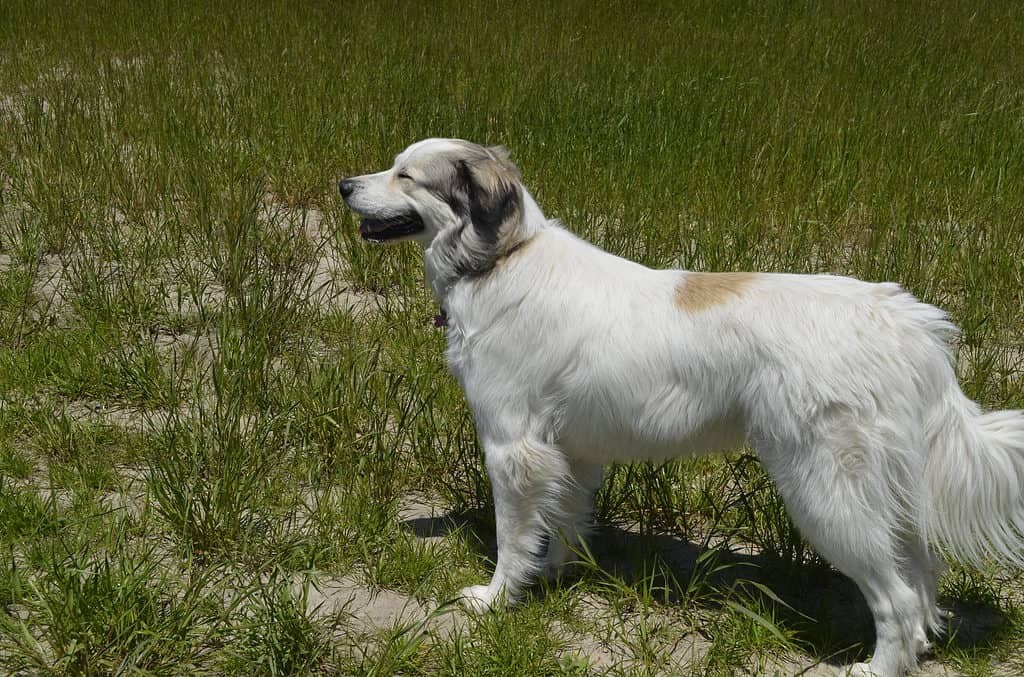
The Pyrenees Cattle Dog mix, a fascinating hybrid between the Great Pyrenees and Australian Cattle Dog (also known as Blue/Red Heeler), combines the best traits of these distinguished working breeds. This designer dog inherits the Great Pyrenees' protective nature and gentle demeanor alongside the Cattle Dog's intelligence and herding instincts. Standing between 18-33 inches tall and weighing 61-100 pounds, these dogs showcase a unique blend of physical and behavioral characteristics. Their versatile temperament makes them suitable for active families seeking a loyal guardian, though they require experienced handling due to their strong-willed nature and substantial exercise needs.
Pyrenees Cattle Dog Mix Physical Attributes
Size and Growth Patterns
While both parent breeds are large dogs, their mixed offspring can vary significantly in size. According to recent data, these mixes typically reach 17-33 inches in height and 33-125 pounds in weight. Growth patterns indicate they achieve full size between 12-18 months, with males generally being larger than females.
Coat Characteristics
The mix exhibits diverse coat patterns combining traits from both breeds. Common colors include white, black and tan, tricolored coats with speckled or mottled markings. The double coat is weather-resistant and can be either short to medium length, requiring regular grooming to manage seasonal shedding. The Great Pyrenees genetics typically contribute more to the coat color, while the cattle dog influence appears in the speckling and mottling patterns.
Overview and Breed History of the Pyrenees Cattle Dog Mix
Origin and Development
The Pyrenees Cattle Dog Mix emerged from crossing two historic working breeds - the Great Pyrenees, originally from the French mountains as livestock guardians, and the Australian Cattle Dog (Heeler), developed in the 19th century Australia for herding. This designer mix combines the Great Pyrenees' protective instincts with the Heeler's herding abilities.
Historical Working Roles
While both parent breeds were working dogs, they served distinct purposes - the Great Pyrenees earned royal recognition as the "Royal Dog of France" during King Louis XIV's reign for guarding chateaux, while the Heeler's lineage includes crosses with Dingoes to create a hardy herding dog suited for Australian conditions. The mix inherits traits valuable for both guarding and herding work, though individual dogs may lean more toward one parent breed's working style.
Care Requirements and Training Guidelines
Essential Care Needs
While previous sections covered physical traits, here we focus on daily care. These mixes require high-quality large-breed food and careful portion control to prevent bloat. Their thick double coat needs weekly brushing with increased frequency during shedding seasons. Regular ear cleaning and nail trimming are essential preventive care measures.
Training Approach
Building on earlier temperament discussions, this mix requires specialized training starting in puppyhood to manage their independent nature. Use positive reinforcement methods and establish clear boundaries early. Key training priorities include:
- Impulse control exercises to manage herding instincts
- Consistent socialization with various people/situations
- Basic obedience combined with mentally stimulating tasks
- Early exposure to different environments to prevent guarding tendencies
Professional training classes are recommended for first-time owners of this mix.
Pyrenees Cattle Dog Mix Health Considerations
Genetic Health Risks
While previous sections covered general care, this focuses specifically on inherited conditions. These mixes are prone to eye disorders like progressive retinal atrophy, joint issues including hip dysplasia and patellar luxation, and potential deafness from their Heeler lineage. The Great Pyrenees genetics also make them susceptible to bloat (GDV), requiring careful feeding schedules.
Preventive Health Measures
Beyond standard veterinary care, these dogs need regular joint health monitoring due to their size. Preventive measures include:
- Weight management to reduce joint stress
- Regular eye and hearing examinations
- Feeding smaller, frequent meals to prevent bloat
- Joint supplements as recommended by veterinarians
- Exercise moderation during growth phases
Early detection through consistent health screenings helps manage these conditions effectively and supports a typical lifespan of 10-16 years.
Conclusion
The Pyrenees Cattle Dog Mix represents a unique blend of two historic working breeds, combining the protective instincts of the Great Pyrenees with the herding capabilities of the Australian Cattle Dog. These large dogs typically range from 17-33 inches in height and 33-125 pounds in weight, featuring distinctive double coats that require regular maintenance. Their diverse physical attributes are matched by complex care needs, including specialized training requirements and careful health monitoring.
The research indicates that while these mixes can make excellent working and companion dogs, prospective owners should be prepared for significant commitments in terms of training, exercise, and preventive healthcare. Key considerations include early socialization, positive reinforcement training methods, and vigilant monitoring for inherited health conditions like hip dysplasia and eye disorders. With proper care and attention to their unique needs, these dogs can live 10-16 years as capable and loyal companions, though first-time dog owners may benefit from professional training support to manage their independent nature and strong working instincts.